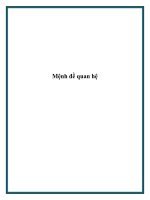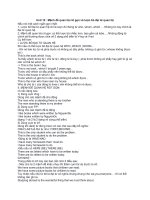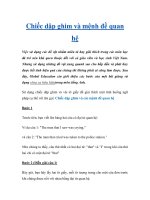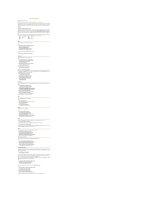Mệnh đề quan hệ các hình thức rút gọn (đặc biệt)
Bạn đang xem bản rút gọn của tài liệu. Xem và tải ngay bản đầy đủ của tài liệu tại đây (151.01 KB, 6 trang )
A. RELATIVE CLAUSES
- Mệnh đề quan hệ (hay mệnh đề tính từ) bổ nghĩa cho danh từ đứng trước nó.
- Mệnh đề quan hệ được đặt sau danh từ mà nó bổ nghĩa, được bắt đầu bằng các đại từ quan hệ:
WHO, WHOM, WHICH, THAT, WHOSE, và trạng từ quan hệ: WHERE, WHY, WHEN.
Danh từ đứng trước
(Antecedent)
Chủ ngữ
(Subject)
Tân ngữ
(Object)
Sở hữu cách
(Possesive Case)
Người (person) Who/That Whom/That Whose
Vật (Thing) Which/That Which/That Of which/ whose
1. Đại từ quan hệ (Relative Clauses)
1.1. WHO (thay thế cho người, làm chủ từ trong MĐQH).
Ex: - I need to meet the boy. The boy is my friend’s son.
à I need to meet the boy who is my friend’s son.
- The woman is standing over there. She is my sister.
àThe woman who is standing over there is my sister.
1.2. WHO/ WHOM (thay thế cho người, làm túc từ trong MĐQH).
Ex: - I know the girl. I spoke to this girl.
à I know the girl who/ whom I spoke to.
- The man is my teacher. Your father is talking to him.
à The man who/ whom your father is talking to is my teacher.
1.3. WHICH
• Thay thế đồ vật, làm chủ từ, túc từ trong MĐQH.
Ex: - She works for a company. It makes cars
à She works for a company which makes cars.
- The elephants are big. People keep the elephants in iron cages.
à The elephants which people keep in iron cages are big.
• Thay thế cho cả mệnh đề đứng trước nó
Ex: He passed his exam. This pleased his parents.
à He passed his exam, which pleased his parents. (dùng dấu phẩy trước đại từ quan hệ)
1.4. THAT (thay thế cho WHO/ WHOM/ WHICH trong MĐQH xác định)
Ex: - I need to meet the boy that/ who is my friend’s son.
- The woman that/ who is standing over there is my sister.
- I know the girl that/ who/ whom I spoke to.
- The man that/ who/ whom your father is talking to is my teacher.
- She works for a company that/ which makes cars.
- The elephants that/ which people keep in iron cages are big.
Những trường hợp thường dùng THAT:
Sau cụm từ quan hệ vừa chỉ người và vật:
Ex: He told me the places and people that he had seen in London.
Sau đại từ bất định: something, aynyone, everything, nothing, nobody, all, much
Ex: I’ll tell you something that is very interesting.
All that is mine is yours.
Nothing that anyone does can replace my lost bag.
Sau các tính từ so sánh nhất và only, first, last
Ex: This is the most beautiful dress that I have.
You are the only person that can help us.
Trong cấu trúc: It + be + … + that … (chính (là) …)
Ex: It is my friend that wrote this sentence.
(Chính (là) bạn tôi đã viết câu này.)
Những trường hợp không dùng THAT:
Trong mệnh đề tính từ không xác định.
Ex: Mr Brown, that we studied English with, is a very nice teacher.
Sau giới từ
Ex: The house in that I was born is for sale.
1.5. WHOSE (OF WHICH) (thay thế cho sở hữu của người, vật (my, your, his, her, its,
our, their )).
Ex: - John found the cat. Its leg was broken.
à John found the cat whose leg/(the leg of which) was broken.
- This is the student. I borrowed his book.
àThis is the student whose book I borrowed.
1.6. OF WHICH / OF WHOM:
- All of/ none of/ neither of/ any of/ either of + whom (people)
- Most of/ some of/ many of/ much of/ (a) few of
- Both of/ half of/ each of/ one of/ two of … + which (things)
Ex: - Daisy has three brothers. All of them are teachers.
à Daisy has three brothers, all of whom are teachers.
- He asked me a lot of questions. I couldn’t answer most of them.
à He asked me a lot of questions, most of which I couldn’t answer.
1.7. Giới từ đặt trước mệnh đề tính từ: (WHOM/WHICH)
Ex: - The man speaks English very fast. I talked to him last night.
à The man to whom I talked last night speaks English very fast.
- The house is for sale. I was born in it.
à The house in which I was born is for sale.
* KHÔNG dùng THAT sau giới từ.
2. Trạng từ quan hệ (Relative Adverbs)
2.1. WHERE (in/ on/ at which): thay thế cho cụm từ chỉ nơi chốn
Ex: - The movie theater is the place. We can see films at that place.
à The movie theater is the place where we can see films.
2.2. WHEN (in/ on which): thay thế cho cụm từ chỉ thời gian
Ex: - Do you remember the day. We first met on that day.
à Do you remember the day when we first met?
2.3. WHY (for which): thay thế cho cụm trạng từ chỉ lí do
Ex: - Tell me the reason. You are so sad for that reason.
à Tell me the reason why you are so sad.
CÓ 2 LOẠI MỆNH ĐỀ LIÊN HỆ:
RESTRICTIVE & NON-RESTRICTIVE RELATIVE CLAUSES
I. Restrictive Relative Clauses: (Mệnh đề quan hệ xác định)
- Dùng để bổ nghĩa cho danh từ đứng trước chưa được xác định rõ, nếu bỏ đi mệnh đề chính sẽ
không rõ nghĩa.
Ex: - I saw the girl. She helped us last week.
à I saw the girl who/that helped us last week.
* LƯU Ý: Ta có thể bỏ đại từ quan hệ: WHO, WHOM, WHICH, THAT khi chúng làm tân ngữ trong
MĐQH xác định.
II. Non-restritive Relative Clauses: (Mệnh đề quan hệ không xác định)
- Dùng để bổ nghĩa cho danh từ đứng trước đã được xác định rõ (nó chỉ là phần giải thích thêm),
nếu bỏ đi mệnh đề chính vẫn rõ nghĩa.
- Mệnh đề này ngăn cách với mệnh đề chính bằng dấu phẩy.
- Ta dùng mệnh đề quan hệ không xác định khi:
+ Trước đại từ quan hệ có: this/ that/ these/ those/ my/ her/ his/ their…
+ Từ trước đại từ quan hệ là tên riêng, danh từ riêng, vật duy nhất, cụm trạng ngữ chỉ nơi
chốn
Ex: - My father is a doctor. He is fifty years old.
à My father, who is fifty years old, is a doctor.
- Mr. Brown is a very nice teacher. We studied English with him.
à Mr Brown, who we studied English with, is a very nice teacher.
- The sun made the traveller thirsty. It was hot at midday.
à The sun, which was hot at midday, made the traveller thirsty
- The boys in the next room are my students. They are making noise.
à The boys in the next room, who are making noise, are my students.
* LƯU Ý: KHÔNG được bỏ đại từ quan hệ trong MĐQH không xác định.
B. REDUCTION OF RELATIVE CLAUSES (mệnh đề quan hệ rút gọn)
1. Ta có thể dùng participle clauses (present & past participle) sau danh từ để bổ nghĩa cho danh
từ đó giống mậnh đề quan hệ. Ta có thể gọi đó là hình thức rút gọn của mệnh đề quan hệ.
1.1 Present participle ( V-ing ): được dùng cho các mệnh đề mang nghĩa chủ động (active
relative clause)
Ex: The man who is standing there is my brother.
à The man standing there is my brother
Students who hand in their essays late will lose ten marks.
à Students handing in their essays late will lost ten marks.
LƯU Ý: Ta không dùng hình thức rút gọn này nếu ta đang nói về hành động đã kết thúc
trong quá khứ và ko lặp lại nữa.
EX: Who was the boy who broke the window?
Not: Who was the boy breaking the window?
They haven’t caught the man who stole my motorbike last week
Not: They haven’t caught the man stealing my motorbike last week
1.2 Past participle ( P.P: V3/ V-ed) : được dùng trong mệnh đề quan hệ mang nghĩa bị động
(passive relative clause)
Ex: I like books which were written by Nguyen Du.
à I like books written by Nguyen Du.
This vase, which was made in China in the 14
th
century, is very valuable
à This vase, made in China in the 14
th
century, is very valuable
She likes eating cakes that are made by her mother
à She likes eating cakes made by her mother
2. T o inf: ( Noun/ Pronoun + to infinitive / to be + P.P )
- Được dùng khi danh từ đứng trước có các từ: ONLY, LAST, FIRST, SECOND
Ex: This is the only student who can do the problem. (động từ mang nghĩa chủ động)
à This is the only student to do the problem.
He is the first member in my family who wins the lottery.
à He is the first member in my family to win the lottery
- Được dùng khi trong câu có động từ HAVE
Ex: I have something that I must do now. (động từ mang nghĩa chủ động)
à I have something to do now.
- Câu bắt đầu bằng: HERE (BE), THERE (BE)
Ex: There are six letters which have to be written today. (động từ mang nghĩa bị động)
à T here are six letters to be written today.
LƯU Ý: Trong phần to inf này cần nhớ 2 điều sau:
- Nếu chủ ngữ trong 2 mệnh đề khác nhau thì phải thêm for + sb trước to inf.
Ex: We have some picture books that children can read.
à We have some picture books for children to read.
Tuy nhiên nếu chủ ngữ là đại từ có nghĩa chung chung như: we, you, everyone thì có thể
không cần thêm for + sb.
Ex: Studying abroad is the wonderful thing that we must think about.
à Studying abroad is the wonderful (for us ) to think about.
- Nếu trước relative pronoun có giới từ thì phải đem xuống cuối câu.
Ex: We have a peg on which we can hang our coat.
We have a peg to hang our coat on.
3. Being + past participle: được dùng trong mệnh đề mang nghĩa bị động thể tiếp diễn
(continuous passive relative)
Ex: I like the building which is being buit on CMT8 Street.
à I like the building being built on CMT8 Street.
4. Các trường hợp khác:
- Ta có thể lược bỏ đại từ quan hệ (relative pronoun) & động từ theo sau trong trường hợp:
o Theo sau nó là danh từ hoặc cụm danh từ (noun/ noun phrase)
Ex: Football, which is a popular sport, is very good for health.
à Football, a popular sport, is very good for health.
o Theo sau nó là cụm giới từ (preposition phrase)
E x : The man who is in the house is my father
à The man in the house is my father
The books that are on the desk are mine
à The books on the desk are mine
o Động từ chính trong mệnh đề quan hệ ở thể tiếp diễn (progressive/ continuous)
E x: The man who is swimming in the lake is my father
à The man swimming in the lake is my father
The books that are lying on the floor are mine
à The books lying on the floor are mine
- Ta có thể lược bỏ đại từ quan hệ nếu theo sau nó là 1 new Subject + Verb.
E x: This is the house that Jack built
à This is the house Jack built
The person whom you see is my father.
à The person you see is my father
This is the place where I live
à This is the place I live
I don’t know the reason why she is late
à I don’t know the reason she is late
(also: I don’t know why she is late)









